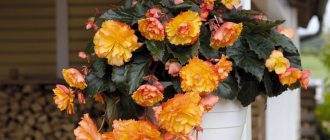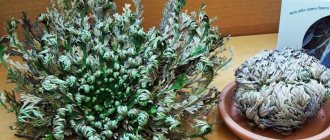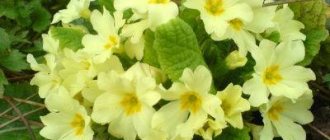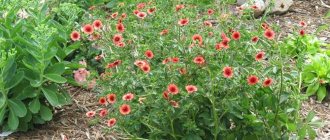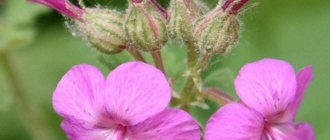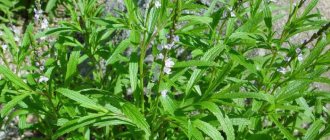Ampelous begonia is the most decorative and beautiful variety of begonias. The flowing shape of the bush, long flowering and variety of flower colors make this plant one of the most popular in vertical gardening. In flowerpots and hanging flowerpots, ampelous begonia will become an exquisite decoration for your home, balcony or terrace, and planting and caring for plants will not cause you much trouble. Watering and fertilizing is all that begonia needs for lush flowering from spring to late autumn.
general characteristics
The peculiarity of ampelous begonia is its graceful hanging shoots, reaching a length of 30–45 cm, and forming a picturesque cascade of bright flowers. The buds are formed in the leaf axils at the level of 5–6 nodes and have elongated pedicels. Begonia flowers are of two types: male - double, large (up to 8 cm in diameter), and female - simple and smaller (about 5 cm).
Begonia blooms continuously and for a long time, starting in mid-May and, if it is provided with proper care, lasts until the beginning of autumn. Ampelous varieties are ordinary and tuberous. Tuberous begonia is dug up for the winter, and with the arrival of spring, the tubers are sprouted and planted again. Regular, non-tuberous varieties are easier to grow using cuttings.
Popular varieties
The number of modern hybrids of ampelous begonia is so large and diverse that they form entire series. Almost all varieties are resistant to weather conditions and are not damaged by rain drops, as happens with other types. The Pendula and Chanson series are considered the most beautiful and in demand in gardening.
Begonia Pendula is a tuberous variety suitable for growing in pots. It is compact and quickly forms buds that bloom before the leaves appear. The flowers are large, often double, mostly red and pink.
White begonia Chanson
Yellow begonia Chanson
Red Begonia Pendula
Orange Begonia Pendula
Begonia Chanson - this series consists of a dozen varieties of various shades: white, yellow, salmon, vanilla, red. There are also a couple of hybrids with two-tone variegated colors. All varieties from this series have double or semi-double flowers with a diameter of 6–8 cm. Chanson is considered the most decorative ampelous variety.
Landing Features
Ampelous begonia is grown in hanging pots or pots on a stand, allowing the stems to grow vertically. The time and method of planting depend on the variety. Some varieties do not need winter rest and bloom all year round. Their cuttings can be planted as early as early January, so that the buds will bloom by spring, and put indoors for the winter. If the begonia is tuberous, then it is planted in the spring, when the tubers begin to wake up.
Planting material is disinfected in a 1% solution of potassium permanganate or peroxide, then the tubers are cut so that each part has at least two buds and planted in pots with the buds facing up. A drainage layer is required. It is important to know that begonias need slightly acidic soil. The ideal option for it is a soil mixture consisting of equal parts of foliage, turf soil, sand and a small amount of vermiculite.
Planting ampelous begonia
To grow a good specimen of ampelous tuberous begonia, you need to select healthy, strong tubers for planting. In the store you should buy tubers whose diameter exceeds 3 cm. Small-flowered varieties are an exception. Preference should be given to well-cleaned specimens, without stains or damage. The upper (concave) part of them should be dense. There are tubercles and irregularities visible on it - these are the kidneys. Those tubers that have from three to seven buds are good.
Before planting, the tubers are kept with the lower, convex side on a damp cloth, sand or suitable soil in warmth and light. In this case, the planting material is occasionally sprinkled with warm soft water and a weak solution of Epin. They can be planted when tiny white roots appear on the convex part.
Pots for hanging begonias need to be small and wide. Containers for planting must have a drainage hole, on which shards and drainage are placed on top. The soil used is loose and nutritious; it can be pre-treated with a fungicide.
The prepared tubers are laid out with the convex side on moist (but not wet) soil and the space around is filled, leaving the upper part free. In this case, the top should be located a couple of centimeters below the edge of the pot. Until the sprouts appear, the tubers are not covered to the top with soil.
Plantings of hanging begonias are kept in a warm, bright place. Water very carefully, trying not to get on the tuber. When the third leaf blooms on the sprout, the tuber is covered with soil completely, but not deeply.
Rules of maintenance and care
Ampelous begonia prefers sunny places, but the plants need to be placed so that the sunlight is diffused. A comfortable temperature for it is 20–22 °C, so in summer it is better to place the pots in partial shade. How to care for ampelous begonia? There is nothing special or complicated about this.
Care at home and in the garden consists of regular watering and fertilizing. To prevent the tuber from rotting, it is better to pour water along the edge of the pot. When watering, do not allow the soil to become waterlogged or dry out.
For lush flowering, plants need to be fed.
In the spring, nitrogen fertilizers are applied, and during the entire flowering period, potassium-phosphorus mixtures are applied at intervals of 2 times a month. It is advisable to alternate mineral fertilizers with organic ones. Flower care also includes timely removal of faded buds.
Seedling care
As soon as you notice the first bores, you must immediately remove the container from the windowsill and protect the seedlings from sunlight. At this moment she becomes very tender and fragile. Don't forget to moisturize. It is best to do this through a pallet, so as not to affect this fragile creature again. The room temperature should now be +20 degrees.
If you sowed the seeds earlier, for example, in December, and in January you already have the first shoots, then they will not have enough sunlight. For additional lighting, you can use a special lamp. Borers should be under this device for about 12-14 hours a day.
You may also be interested in: Growing garden buttercups in open ground
Don't forget that ventilation is very important during this period. To do this, it is recommended to remove the glass or cling film for only 20-30 minutes. And gradually add time so that in the future, namely in two weeks, it could be removed altogether. This must be done daily.
Make sure that all the bores are freed from their shells. If for some reason this does not happen, then the future flower can be helped and the shell carefully removed using an ordinary match or toothpick.
Picking
Picking for any plant is very important. For begonia, this moment occurs after 50-60 days. For this procedure, it is best to take an ordinary plastic cup. The same steps are performed as for sowing.
It is necessary to pour one layer of drainage at the bottom, and then the soil, which was the same as when sowing the seeds. But you need to do this so that there is 1 cm left to the edge of the cup. If you dive into a pot, you can immediately transplant from 3 to 5 sprouts.
Cups with these grown flowers can be placed in containers on windowsills. It is necessary to ensure that they all receive an even amount of light. They need to be turned periodically. It is advisable that after diving the room should be several degrees lower.
Stimulation of growth
Ampelous begonia does not need a procedure such as growth stimulation. Its stems stretch naturally anyway. There is no need to use various stimulants; it is better to feed the plant with complex fertilizer two weeks after picking.
This procedure only needs to be done once every few weeks. When the growing season begins, it is better to add nitrogen fertilizers, and after the first buds appear and flowering begins, a phosphorus-potassium composition.
Before it is necessary to plant the plant in the ground, 20 to 22 weeks must pass from the moment the seeds are sown. Therefore, if you planted begonia in January, then you can safely plant it in May. She is completely ready to bloom.
You may also be interested in: Planting and caring for muscari flowers in the garden
Watering
Begonia ampel tuberous requires abundant watering, especially on hot days. It is advisable to do this with warm, settled water. Begonia's roots are superficial, small and fragile. Therefore, it is necessary to try to avoid waterlogging during watering, and also to prevent water from getting on the leaves.
Before each watering, the soil should be slightly dried. This is especially true during the growing season. After the flowering period has ended, watering is gradually reduced, the above-ground part is cut off, and the pot with tubers is placed in a cool place until spring.
Diseases and pests
If you disrupt the process of caring for begonia, various diseases may occur that can lead to the death of the plant. The flower began to shed leaves and buds - this means there is not enough moisture in the soil and humidity around it.
Pale color indicates that the flower does not have enough lighting. There is a disease called powdery mildew. This is a fungal disease that causes a white coating to appear on the leaves. Then they begin to curl, become deformed and dry out. Consequently, the buds do not open.
Gray rot is also a fungal disease that affects not only the fruit, but also the stem and leaves. For prevention, it is necessary to treat the plant with 1% Bordeaux mixture immediately before and after flowering.
As for pests, aphids, nematodes and spider mites are very harmful to ampelous begonia.
Reproduction techniques
Begonia can be propagated from cuttings, seeds and tubers. The seed method is very labor-intensive and troublesome. The seeds are small and take a long time to germinate; besides, ampelous begonia, when grown from seeds, can bloom only the next year. But the flower is propagated by cuttings and tubers without any problems. A young shoot or leaf is used as a cutting. It needs to be placed in water, germinated, and then planted in a pot. How begonia reproduces by tubers was described above.
Soil and seed preparation
Before you start sowing, you need to prepare the soil and seeds in advance. Let's start with the seeds. They need to be prepared several weeks before sowing. Begonia is usually planted in late February or early March. There are a lot of seeds in the bag and you need to be careful with them. It is advisable to mix them with sand before planting. But most often they are sold in the form of granules and this makes sowing much easier.
Read growing Jameson's gerbera
As for the container and soil where you need to plant begonia seeds, here you need to buy a special box and a peat tablet. You can also buy soil at the store or prepare it yourself. For this you will need:
- one part peat;
- one part sand;
- two parts of leafy soil.
You may also be interested in: Tips for growing Carpathian bellflower from seeds
All this is mixed and poured into a container where the begonia will continue to grow. It is very easy to grow begonia from seeds and you do not need to buy ready-made seedlings.
Disease Prevention
Ampelous begonia is highly resistant to diseases and is rarely damaged by pests. However, improper care or unfavorable weather conditions can contribute to the occurrence of these problems. Thus, with excessive watering and during periods of prolonged rain, fungal diseases (powdery mildew, gray rot) or root infections can develop on plants. When it is not possible to control humidity, it is better to treat flowers with fungicides: 1% Bordeaux mixture or copper sulfate.
In the summer, pests begin to become active: aphids, spider mites, leaf nematodes and other harmful insects. In a matter of days, they can damage the delicate leaves, depriving the plant of its decorative properties. To prevent this from happening, begonias and flowers growing nearby need to be treated with Fitoverm 2-3 times per season. Do not neglect preventive treatments, because they help protect plants and prolong their magnificent flowering.
